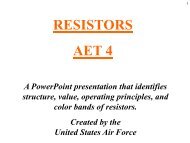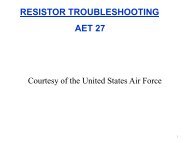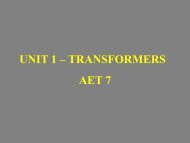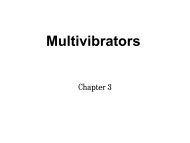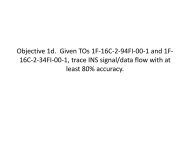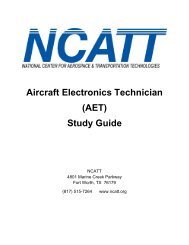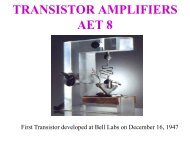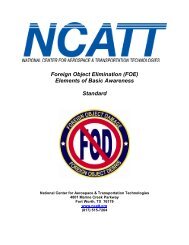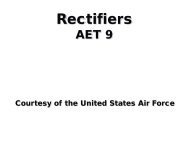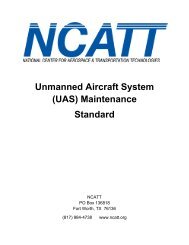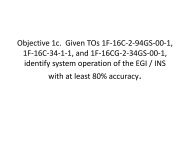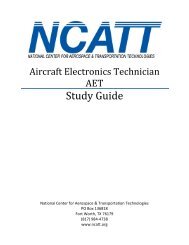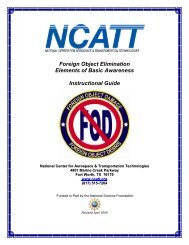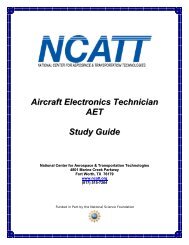FOE - Elements of Basic Awareness - NCATT
FOE - Elements of Basic Awareness - NCATT
FOE - Elements of Basic Awareness - NCATT
Create successful ePaper yourself
Turn your PDF publications into a flip-book with our unique Google optimized e-Paper software.
Foreign Object Elimination<br />
<strong>FOE</strong><br />
<strong>Elements</strong> <strong>of</strong> <strong>Basic</strong> <strong>Awareness</strong>
<strong>Basic</strong> Terms & Definitions<br />
• FO (Foreign Object)<br />
• FOD (Foreign Object<br />
Damage)<br />
• FOD (Foreign Object<br />
Debris)<br />
• <strong>FOE</strong> (Foreign Object<br />
Elimination)<br />
• FOD Walk / Sweep<br />
• FOD Sensitive Area<br />
• Critical FO<br />
• Clean As You Go<br />
• Consumables / MSP<br />
(Miscellaneous Small<br />
Parts)<br />
• PLS (Production Line<br />
Stock)<br />
• 6S—Six Sigma<br />
• Lean Manufacturing<br />
• 5S<br />
• Focal Point<br />
• FOD POC (Point <strong>of</strong><br />
Contact)<br />
• Housekeeping<br />
• FOD Barriers
Examples <strong>of</strong> Foreign Object or<br />
Debris
Housekeeping<br />
• Housekeeping—The responsibility <strong>of</strong> employees to maintain a<br />
clean and orderly work area with necessary tools, materials, and<br />
equipment in their places <strong>of</strong> orderly arrangement.<br />
• Clean As You GO!!<br />
• FOD Cans and Containers<br />
• FOD Bags<br />
• 5S is stands for Sort, Straighten, Shine, Standardize, and Sustain.<br />
5S describes a Japanese concept for housekeeping and<br />
organization <strong>of</strong> the workplace. Some companies use 6S to include<br />
Safety.<br />
• FOD Walk / Sweep
Tool Accountability<br />
Types <strong>of</strong> Tool Accountability:<br />
– Shadow Boards & Shadowboxing<br />
– Tether<br />
– Chit System<br />
– Tool Inventory Sheets/Logs<br />
– Tool Pockets<br />
– Tool Identification<br />
– Consolidated Tool Kits<br />
– Tool Conditions<br />
– Sponge Count<br />
– Electronic Tool Accountability System
Shadow Box and Shadow Board
Tool Inventory Sheet
Hardware Accountability<br />
• Kitted Hardware —Is the exact amount <strong>of</strong> hardware assigned to<br />
perform a task (No Spare Parts).<br />
• Method for Hardware Replacement<br />
• Maintenance <strong>of</strong> existing permanent tooling in a FOD Sensitive Area<br />
(FSA)<br />
• Repair <strong>of</strong> existing FOD Sensitive Hardware<br />
• Removal/Installation Paperwork to track loose parts<br />
• Containers & Tote Trays<br />
• Methods for Hardware Storage
Examples <strong>of</strong> MSP (Miscellaneous Small<br />
Parts) Consumables, & Foreign Objects<br />
and Debris
Lost Items<br />
• Report Missing, Lost & Found Items<br />
– Integral part <strong>of</strong> having a successful Foreign<br />
Object Elimination Program<br />
– All technicians are encouraged and responsible<br />
to report missing, lost or found items<br />
– At most facilities there are NO repercussions for<br />
reporting a lost or missing tool even if the<br />
technician is at fault<br />
– Reporting lost items before they cause damage<br />
is typically a documented process <strong>of</strong> steps
Lost Items<br />
• Search <strong>of</strong> Items<br />
– Cease activity in the affected area and initiate a search<br />
for the item.<br />
– Continue this search until the item is found or adequate<br />
assurances are made that the item is not contained in the<br />
aircraft, aerospace vehicle or assembly.<br />
– Search may require de-paneling or nondestructive<br />
inspections, including flashlight and mirror, borescope<br />
and/or x-ray.<br />
– If an item cannot be located annotate the applicable<br />
forms with a description <strong>of</strong> the item and the search<br />
procedure that was followed.
Physical Entry & Personnel Control<br />
• FOD Restricted / Controlled Area—A FOD<br />
restricted / controlled area is visually noticeable and<br />
physically identified by floor taping and / or roped<br />
<strong>of</strong>f by stanchions, placards, and banners.<br />
• FOD Sensitive / Critical Area—Any area where<br />
flight hardware is in place and exposure to foreign<br />
objects would potentially cause a system or product<br />
failure due to deterioration, malfunction or damage.
Reporting & Investigating<br />
• All Foreign Object Damage should be reported<br />
immediately and investigated as soon as possible<br />
• Follow established procedures for formally reporting<br />
FOD incidents as they may vary from company to<br />
company based on contractual requirements.<br />
• All FOD incidents reports should be forward to the<br />
FOD focal point (see definitions) for investigation,<br />
cause and corrective action.
Material Handling<br />
• Control Techniques<br />
– Materials and accessories used in the packaging, handling,<br />
shipping and storage that have intimate contact with the part<br />
or assembly should be clean and free <strong>of</strong> contamination.<br />
– Parts and assemblies should be packaged in a manner that<br />
will preclude any chance <strong>of</strong> one item making contact with<br />
another during normal handling operations.<br />
– Protective and packaging materials should be chosen based<br />
on their ability to adequately resist penetration by tearing,<br />
parting or piercing from forces either external or internal<br />
during normal handling operations.
Material Handling<br />
• Control Techniques<br />
– Specific instructions for packaging/unpackaging/handling<br />
should be followed when provided.<br />
– Protective devices (edge protectors, caps, plugs, covers,<br />
filters, rub strips) should be cleaned and secured to prevent<br />
accidental damage. Once installed, unauthorized removal <strong>of</strong><br />
the protective devices is prohibited and should be controlled<br />
through assembly or maintenance paperwork.<br />
– Consideration should be given to the visibility/detection <strong>of</strong><br />
material used for Protection so that the material itself doesn’t<br />
become FOD.
Material Handling<br />
• Material Characteristics<br />
– Materials should be compatible with the<br />
environmental and physical stresses expected to be<br />
encountered during product service.<br />
– Static sensitive devices should be properly<br />
protected to avoid damage. Materials that are used<br />
to protect electro-explosive devices and sensitive<br />
electronic components should be kept clean,<br />
covered, and stored away from ordinary non-static<br />
safe materials.
Material Handling<br />
• Material Characteristics<br />
– Condition—Visually inspect all packaging, handling, shipping<br />
and storage containers for the following:<br />
• Nicks, dents, holes, abrasions, scratches, bums, etc., which may be<br />
detrimental to the function and integrity <strong>of</strong> the part or assembly.<br />
• Grease, preservatives, corrosion products, weld slag, shop and other<br />
dirt, and other materials foreign to the item.<br />
– Packaging / Containers—Packaging and containers can be<br />
a source <strong>of</strong> Foreign Objects debris and could result in<br />
Damage. There may be design considerations for FOD<br />
sensitive product, vehicle or assemblies and the proper<br />
packaging or containers will be used. Certain material can<br />
not be used with FOD sensitive product, vehicle or<br />
assembly.
Material Handling<br />
• Material Characteristics<br />
– Opening and Closing Containers – Caution must be taken<br />
when closing and opening containers. Nailing, strapping or<br />
installing screws can cause damage to hardware or provide<br />
additional internal FOD in the container.<br />
– Storage—Follow the storage procedures to prevent damage.<br />
Improper storage procedures can be a cause <strong>of</strong> Foreign<br />
Object Damage.<br />
– Transportation—Follow transportation procedures to prevent<br />
damage. Transporting FOD sensitive products can be a<br />
cause <strong>of</strong> Foreign Object Damage. This consideration<br />
includes the responsibility <strong>of</strong> transportation vehicles to be<br />
free <strong>of</strong> loose debris while transporting FOD sensitive<br />
products.
Parts Protection<br />
• FOD Barrier- A device used to protect electronic<br />
components and other hardware that are exposed<br />
to potential damage.<br />
• Electrostatic Discharge (ESD) – ESD can be<br />
considered a source <strong>of</strong> Foreign Object Damage. If<br />
a FOD sensitive product, vehicle or assembly is<br />
also ESD Sensitive, proper handling should be<br />
utilized as to prevent ESD from becoming a Foreign<br />
Object Damage cause. ESD is a complex subject.<br />
The technician should seek additional and updated<br />
ESD training prior to handling ESD sensitive<br />
products.
Hazardous Materials<br />
• Management <strong>of</strong> hazardous waste materials is important<br />
in the prevention <strong>of</strong> Foreign Object Damage.<br />
– Disposition is dependent upon the commodity<br />
– Consult federal, state and local Hazardous Material Procedures<br />
for disposal specifics.<br />
• Handling - Improper handling <strong>of</strong> Hazardous Material can<br />
be cause <strong>of</strong> Foreign Object Damage to FOD sensitive<br />
products.<br />
• Disposal - Improper Disposal <strong>of</strong> Hazardous Material can<br />
be cause <strong>of</strong> Foreign Object Damage to FOD sensitive<br />
products.
Wildlife/Environment<br />
• Examples <strong>of</strong> Wildlife as FOD<br />
– Birdstrikes<br />
– Wildlife on Runways<br />
– Wildlife matter introduced to aerospace components<br />
• Examples <strong>of</strong> Environment as FOD<br />
– Snow, rain, hail, wind, and ice are foreign to aircraft<br />
and other aerospace products and can cause<br />
damage.
FOD Effects<br />
• Costs<br />
– Industry losses between <strong>of</strong> $4 - 6 billion a<br />
YEAR to FOD.<br />
• Life<br />
– FOD can result in the loss <strong>of</strong> life.<br />
• Example:. The Concord Crash in Paris France<br />
killed 113 people due to a Foreign Object.
Example 1: DC-10 Engine Damage<br />
Accredited to George<br />
Morse (800) 657-5664<br />
and Thanks to George<br />
for his support<br />
george@fod.com<br />
www.fod.com
Example 1: DC-10 Engine Damage<br />
Courtesy <strong>of</strong> George Morse
Example 1: DC-10 Engine Damage<br />
Conclusion<br />
Crescent Wrench was the<br />
Source <strong>of</strong> the Thread marks<br />
Courtesy <strong>of</strong> George Morse
Failure Analysis Results
Additional Resources<br />
•National Center for Aircraft Technician Training—www.ncatt.org<br />
•FAA Advisory Circulars 150/5370-2E &150/5380-5B—www.faa.gov<br />
•National Aerospace Standards 412 Aerospace Industries Association<br />
www.aiaaerospace.org<br />
•National Aerospace FOD Prevention Inc. Guidelines—www.nafpi.com<br />
•The FOD Control Cooperation<br />
www.fodcontrol.com, www.fodnews.com, www.makeitfodfree.com<br />
•Wildlife and Bird Strike Organization—www.birdstrike.org



